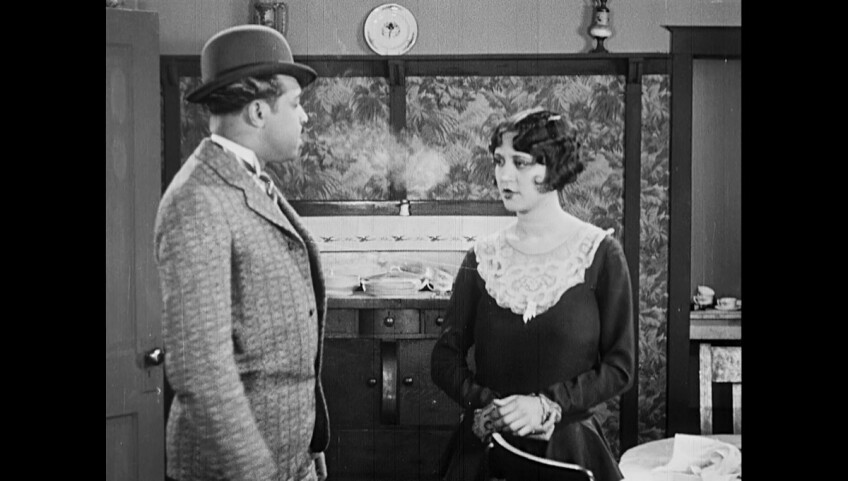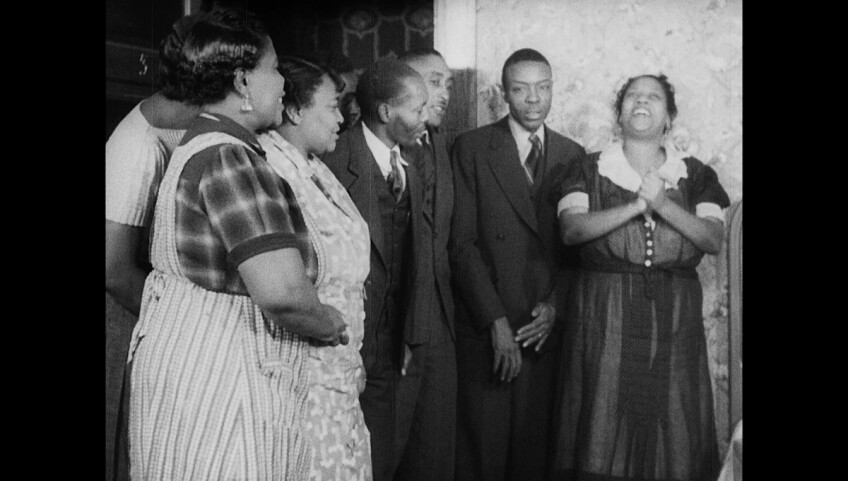Forgotten Black Women of Early Hollywood Take Center Stage at CAAM

Hollywood has long had a problem with representation and diversity, especially concerning anyone female and nonwhite. In the first half of the 20th century, black women were largely relegated to playing mammy and jezebel roles. D.W. Griffith’s 1915 classic “Birth of a Nation” even depicted African Americans as rapists and imbeciles, leading to a resurgence of the Ku Klux Klan.
The black woman’s unfortunate standing in Hollywood history is why the California African American Museum’s “Center Stage: African American Women in Silent Race Films,” which runs until October 15, is so significant. It reveals how as early as 100 years ago, independent black filmmakers presented complex portrayals of women of color that major studios never fathomed. These silent gems depict black women exploring their religious faith, fighting for the rights of African Americans and in loving relationships. They underscore how even today Hollywood has much ground to cover in its depiction of black women.

Among the exhibit’s treasures is the 1920 film “Within Our Gates,” the oldest surviving feature by an African American director. In it, director Oscar Micheaux makes a plea for society to recognize African Americans as equals while highlighting the plight of black women in particular. The silent film asserts that “a woman, though a Negro, was a HUMAN BEING.”
Starring Evelyn Preer as an educated black woman trying to fund a school for sharecroppers’ children, “Within Our Gates” tackles a number of controversial social issues, including suffrage, lynching and miscegenation. It belongs to the cinematic canon known as race films, which featured black casts and were designed for black audiences. With its complex heroine — Sylvia Landry endures heartbreak, betrayal and predatory men —“Within Our Gates” is one of five films featured, including 1921’s “By Right of Birth” and 1920’s “The Symbol of the Unconquered.”

Tyree Boyd-Pates, CAAM’s history curator and program manager, curated the exhibit, along with the UCLA Digital Humanities Department.
“I wanted to tackle some of the discussions about film and diversity contemporarily,” Boyd-Pates said. “The films feature nuanced and exemplary portrayals of black women that I felt would resonate with audiences today.”
The chance to introduce Evelyn Preer to a new generation, especially young black filmmakers, excited the curator. A Chicagoan by way of Vicksburg, Miss., Preer made her film debut in Micheaux’s 1919 film “The Homesteader.” Before her death from pneumonia at age 36, the actress starred in 16 films, including one opposite Cary Grant and Marlene Dietrich in 1932’s “Blonde Venus.” Preer belonged to the Chicago theater troupe the Lafayette Players, and her theatrical training led to praise from white and black critics alike once she transitioned to film. “She moved very fluidly from stage to screen and became one of the most recognizable black actresses of her day,” Boyd-Pates said. “She was known [among blacks] as the ‘first lady of the screen.’”
Preer may have been the first black woman movie star, but film historians lament that today she lacks the name recognition of her white female contemporaries, such as Clara Bow or Mary Pickford.
“For my students, especially students of color, they find it really shocking that no one had told them there was a history of black women determined to be on film in a dignified way that stretched back more than 100 years,” said Miriam Posner, program coordinator and a core faculty member of UCLA’s Digital Humanities Department. “They felt really strongly that people should have told them about this. My students felt like they need to honor that work that had gone unrewarded.”
In “Within Our Gates,” Sylvia Landry not only works to uplift the black community while donning stylish clothing and accessories but also has a loving family and a caring man who courts her — a contradiction to prevalent notions of black women in early Hollywood.
In race films, African American characters counter harmful stereotypes while engaging in work to benefit the black community, Posner said.
“These are films for black people,” she continued. “In no way are they about the concerns of whites or what white people are going to think.”
For the past few years, Posner and her students have sorted through UCLA’s George P. Johnson Negro Film Collection of cinema created from 1916 to 1977. They organized a catalogue of race films because many of these works don’t appear in the Internet Movie Database, the popular online archive of film and television content. Posner and her team aimed to write down the names of every race film they could find. CAAM learned about their efforts and chose them as partners for “Center Stage.”
While the exhibit features two films by Oscar Micheaux, the most prolific black filmmaker of the period, it also features Frank Peregrini’s 1921 standout “Scar of Shame.” The film broaches the subject of sexual abuse and the class divisions in the black community. It stars Lucia Lynn Moses as Louise in a performance that moved CAAM curatorial intern Anastasia Gershman.

Gershman also belonged to the group of UCLA students who worked on the George P. Johnson collection.
“She rocks this role,” Gershman said of Moses. “She has this wonderful, beautiful round face, reminiscent of Clara Bow, deeply expressive eyes. She’s one of those actresses of the period who can really dig deep inside of themselves and access their emotions. This is just a remarkable performance.”
CAAM is also exhibiting 1941’s “Blood of Jesus.” Directed by Spencer Williams, the film stars Cathryn Caviness as Martha, a newly baptized woman who must choose between Christ or worldly temptations. Caviness’ delicate frame, wide eyes and heart-shaped face remind one of contemporary actress Thandie Newton. These traits illuminate Martha’s anguish as the battle for her soul unfolds. The film features old Negro spirituals such as “Swing Low, Sweet Chariot” and striking images of a black congregation in the rural South. Director Williams, who went on to star in controversial TV show “Amos ‘n’ Andy,” also appears in the film as Ras, Martha’s husband.
Filmmaker Julie Dash has cited “Blood of Jesus” as an inspiration for a scene in her 1991 film “Daughters of the Dust.” And a scene in Denzel Washington’s “Fences,” in which churchwomen in white pray over Viola Davis’ Rose, calls to mind the classic race film.

While the actresses in these movies may have given noteworthy performances, little information exists about their lives, with the exception of Preer and Anita Thompson. Thompson starred in “By Right of Birth,” the story of a woman whose white adoptive parents hide her black ancestry from her. In addition to being an actress, Thompson was a model, dancer, nurse, teacher and psychologist. In 2014, Harvard University published her memoir, “American Cocktail: A ‘Colored Girl’ in the World.”
The fact that early black actresses have largely been forgotten doesn’t surprise Aminah Bakeer Abdul-Jabbaar, assistant professor in the Pan-African Studies Department of California State University, Los Angeles. Abdul-Jabbaar teaches early race films to her students.
“The industry as a whole devalues black labor and, of course, black women,” she said. “We’re the mules of America. Hollywood has a problem with gender, and we’re hit with double oppression.”
In fact, the first race films debuted simply due to the entrepreneurial efforts of black filmmakers such as Micheaux, who raised money to get his movies made. Once race films began to make money, the studios took notice and developed race films of their own.
As conversations about diversity and inclusion in Hollywood persist, Boyd-Pates said African Americans should know about the resourcefulness of early black filmmakers who told the stories they wanted to tell without studio backing. As early as 1916, brothers Noble and George Johnson’s Lincoln Motion Picture Company began releasing race films.
“The legacy it’s left us with is the spirit of entrepreneurship and upliftment from communities of color,” Boyd-Pates said. “They had the agency and autonomy to create the representation of blacks they wanted.”
Many early race films have disappeared or have been found just partially intact. That includes “Within Our Gates,” thought to be lost until a copy, titled “La Negra,” turned up in the Spanish Film Archive in Madrid in 1990. Just a handful of the original English intertitles remained, with Spanish intertitles replacing the rest.
CAAM’s exhibit “Gary Simmons: Fade to Black,” which opened July 12, will allude to the erasure of race films. The CalArts graduate will create a painting in the museum’s grand lobby featuring the titles of roughly 30 vintage films in the genre. Simmons’ work focuses on signature erasure techniques in which he draws in white chalk and then smudges the images. They take on a hazy, haunted cast as a result.


“On one level, it’s kind of eerie, the erasure effect,” said Naima J. Keith, CAAM’s deputy director, of exhibitions and programs, and curator of the exhibit. “It’s also a kind of blurring of the drawing that makes it more mysterious. There’s this sense of movement, that time is fleeting, a sense of fading memory. It energizes the words.”
“Fade to Black” will be situated just 10 feet away from “Center Stage,” allowing museumgoers the chance to ponder the provocative names of race films and the woman-centered cinema in this canon.
“These films are really important,” Gershman said. “They offer a window into the black female experience that didn’t really exist elsewhere. It’s a struggle to find roles of black women without pejorative characterizations, and these women were fighting these stereotypes as much as black actresses are fighting these stereotypes now. And they’re doing it beautifully. There’s beauty in the struggle because they never give up.”
Top Image: The Blood of Jesus, 1941. USA. Directed by Spencer Williams | Courtesy Sack Amusement Enterprises/Photofest and California African American Museum


